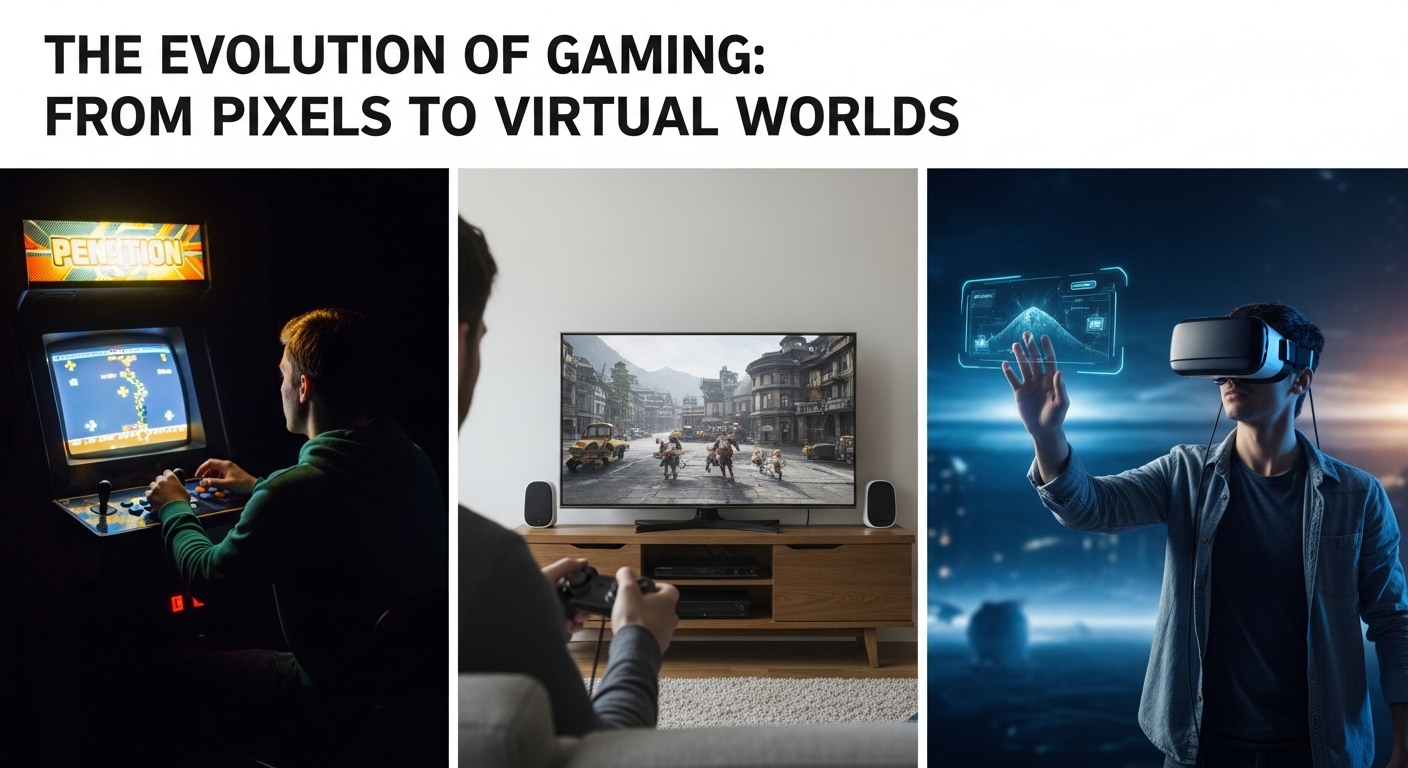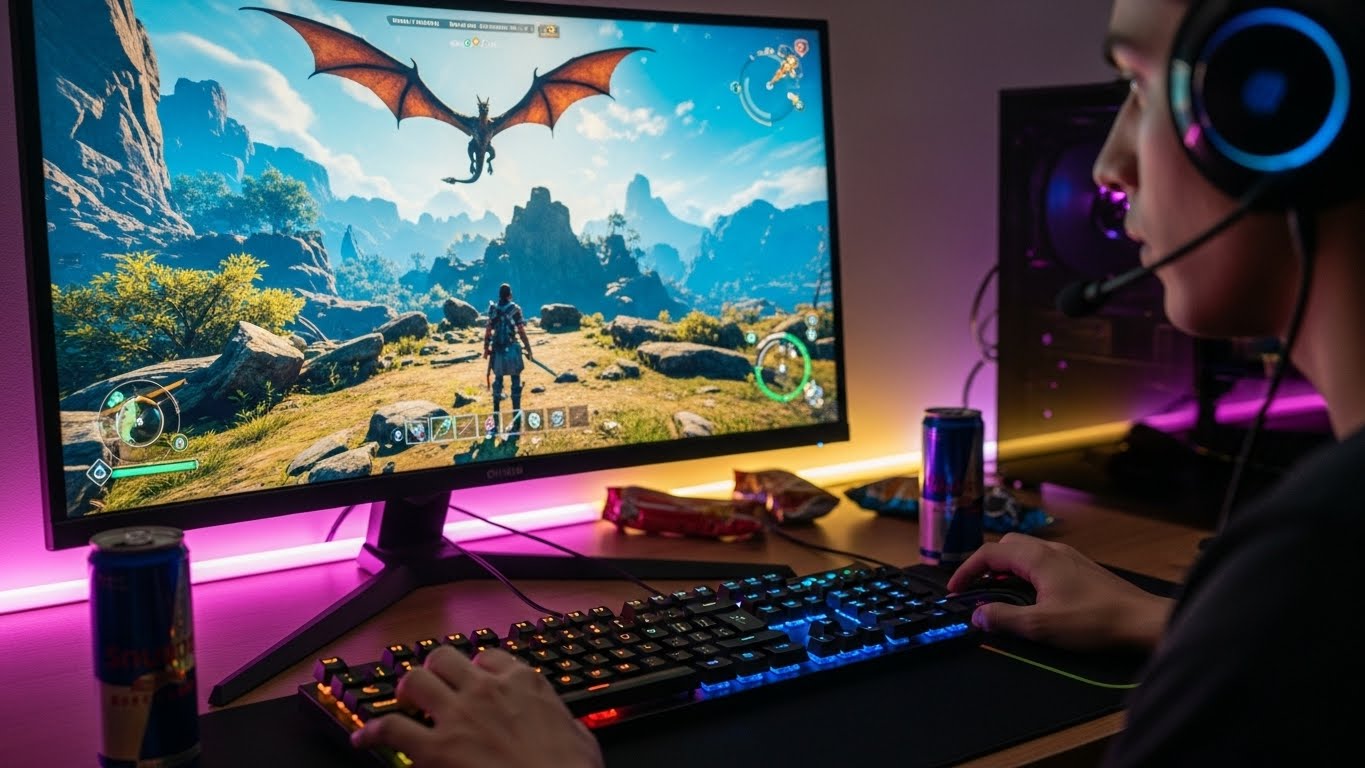Introduction: The Ever-Growing Universe of Games
Gaming has become one of the most influential cultural forces in the modern world. What started as a niche hobby for a handful of enthusiasts in dimly lit arcades has transformed into a multi-billion-dollar global industry that connects millions across continents. It is no longer just a pastime but an art form, a sport, a social platform, and even a career path. Whether it is the nostalgic charm of retro consoles, the immersive depth of open-world adventures, or the competitive thrill of esports tournaments, gaming offers something for everyone.
To understand why gaming is so powerful today, we need to explore where it came from, how it evolved, and why it resonates so deeply with people of all ages and backgrounds.
The Birth of Gaming: A Spark of Imagination
The roots of gaming stretch back to the early 1950s and 60s when scientists and engineers first began experimenting with computers. These machines were massive, expensive, and primarily used for research or military purposes. Yet, some creative minds saw potential for fun.
One of the earliest known games was “Tennis for Two,” created in 1958 by physicist William Higinbotham. It was a simple tennis simulation displayed on an oscilloscope screen, but it marked the beginning of interactive entertainment. Then came “Spacewar!” in 1962, a game developed by MIT students that allowed two players to battle each other using spaceships.
In 1972, gaming entered the public consciousness with the release of “Pong.” Developed by Atari, Pong’s simple premise — bouncing a ball back and forth — captivated millions. The arcade scene exploded, and video gaming began its journey from laboratories to living rooms.
The Console Revolution
The 1980s saw gaming move from the arcade to the home. The release of systems like the Atari 2600, the Nintendo Entertainment System (NES), and the Sega Master System changed everything. Suddenly, people could enjoy their favorite titles without leaving their houses.
Games like “Super Mario Bros.,” “The Legend of Zelda,” and “Sonic the Hedgehog” became cultural landmarks. These games weren’t just about scoring points; they told stories, created worlds, and introduced memorable characters that would last for decades.
The console wars between Nintendo and Sega fueled innovation and competition. Every new generation brought improved graphics, better sound, and more complex gameplay mechanics. Gaming was no longer a novelty — it was a legitimate form of entertainment competing with movies and television.
The Rise of PC Gaming
While consoles dominated the living room, another revolution was brewing on personal computers. In the 1990s, PCs became powerful enough to handle advanced graphics and networking. This led to the birth of genres that defined the future — real-time strategy games like “StarCraft,” first-person shooters like “Doom” and “Half-Life,” and simulation titles like “The Sims.”
PC gaming also introduced the concept of modding, where players could modify or create their own versions of games. This community-driven creativity gave rise to entire new genres. For instance, “Counter-Strike” began as a mod for “Half-Life” before becoming a global sensation in its own right.
Online connectivity transformed PC gaming even further. With the rise of the internet, multiplayer experiences expanded beyond local networks, giving players the ability to challenge or cooperate with others around the world.
The Online Era: Gaming Without Borders
The late 1990s and early 2000s marked the beginning of the online gaming revolution. Titles like “EverQuest” and “World of Warcraft” introduced the concept of massive multiplayer online worlds — virtual universes where thousands of players could interact simultaneously.
Online gaming broke down geographical barriers. Players could form friendships, rivalries, and entire communities across continents. Voice chat, guilds, and forums allowed people to connect deeply over shared experiences.
This era also gave rise to competitive gaming, or what we now know as esports. Games like “Counter-Strike,” “Warcraft III,” and later “League of Legends” became professional competitions with real prizes, sponsorships, and global tournaments.
The Cultural Power of Gaming
Gaming today is more than entertainment; it is a cultural movement. Video games influence music, fashion, film, and even education. Characters like Mario, Master Chief, and Lara Croft have become icons recognized worldwide.
Streaming platforms have further amplified gaming’s reach. With services that allow players to broadcast their gameplay to audiences of millions, gaming has become a form of performance art. Personalities like streamers and content creators build careers entertaining others through games.
Gaming also fosters inclusivity and creativity. It allows people to express themselves through character customization, storytelling, and collaboration. Games like “Minecraft” and “Roblox” are not just about playing — they are about creating, building, and sharing.
The Psychology of Play
Why do people love gaming so much? The answer lies in psychology. Games tap into fundamental human desires — the need for challenge, achievement, connection, and escape.
When players complete a difficult level or overcome a tough opponent, their brains release dopamine, a chemical associated with pleasure and reward. Games are designed around these feedback loops, keeping players engaged and motivated.
Beyond the thrill of victory, games provide a safe space to explore emotions and ideas. They allow people to experience power, fear, empathy, and wonder in controlled environments. A well-crafted story-driven game can evoke emotions as deep as any film or novel.
Gaming also encourages problem-solving, strategic thinking, and teamwork. Many educational institutions now use games to teach concepts in science, math, and history because of their ability to immerse students in interactive learning experiences.
Gaming as Art
For years, debates raged about whether video games could be considered art. Today, the answer seems obvious. The artistry in modern games rivals that of film or literature.
Developers craft visually stunning worlds filled with symbolism, emotion, and meaning. Soundtracks composed for games are performed by orchestras in concert halls. Storylines tackle complex themes like identity, loss, morality, and freedom.
Titles like “Journey,” “The Last of Us,” and “Red Dead Redemption 2” are not just games — they are emotional experiences that provoke thought and reflection. The blending of visual design, music, narrative, and interactivity creates a unique art form that no other medium can replicate.
The Evolution of Technology in Gaming
The progress of gaming is inseparable from the progress of technology. Each generation of hardware opens new creative possibilities.
In the early days, limited memory and processing power meant developers had to be resourceful, creating charm through simplicity. As technology advanced, so did the realism of graphics, the complexity of artificial intelligence, and the scope of worlds.
Modern consoles and PCs render lifelike characters and vast environments with stunning detail. Cloud computing and high-speed internet have enabled game streaming and instant access to massive libraries of content.
Virtual reality (VR) and augmented reality (AR) are pushing immersion even further. With VR headsets, players can physically step into the game world, while AR integrates gaming with the real world, blurring the line between digital and physical experiences.
Artificial intelligence is another frontier. AI-driven NPCs (non-playable characters) can now learn and adapt, making gameplay more dynamic and personalized. The boundaries between player and world are slowly disappearing.
The Social Side of Gaming
Gaming is no longer a solitary activity. In fact, it’s one of the most social experiences in modern culture. Online multiplayer games, voice chats, and shared virtual spaces have created global communities.
Games like “Fortnite,” “Apex Legends,” and “Among Us” have become digital meeting grounds where friends hang out, laugh, and compete. These virtual spaces often serve as social networks — a new kind of digital neighborhood.
Even local co-op gaming still thrives. Split-screen sessions, LAN parties, and family game nights continue to bring people together. The bond formed through shared victories or hilarious defeats is something deeply human.
The Economic Powerhouse
The gaming industry today generates more revenue than movies and music combined. Major releases can cost hundreds of millions of dollars to produce and often outsell blockbuster films.
Publishers, developers, hardware manufacturers, and independent creators all contribute to a thriving ecosystem. Indie games, in particular, have shown that creativity and innovation can succeed without huge budgets. Titles developed by small teams have found critical and commercial success worldwide.
Streaming, esports, and merchandise have added new layers to the economy. Professional gamers earn salaries and sponsorships, while developers profit from downloadable content, expansions, and in-game cosmetics. The gaming world has become a complex economic network driven by passion, innovation, and community.
The Challenges of Gaming
Despite its many positives, gaming also faces criticism and challenges. Concerns about addiction, toxic behavior, and monetization practices have sparked debate.
Some games use psychological tactics to encourage spending, blurring the line between entertainment and exploitation. Online spaces can sometimes foster harassment or exclusion. These issues highlight the need for ethical design and responsible moderation.
Another ongoing conversation surrounds representation. Developers are increasingly aware of the importance of diversity — ensuring that games reflect the broad spectrum of human experience in terms of race, gender, culture, and identity.
The balance between creativity, profit, and responsibility remains one of the industry’s biggest challenges.
The Future of Gaming
The future of gaming is limitless. With technology evolving faster than ever, we are entering an age where the boundaries between the virtual and real worlds blur completely.
Cloud gaming promises to make high-end titles accessible on any device, removing the need for expensive hardware. Artificial intelligence could create games that adapt dynamically to each player’s personality and choices.
Virtual reality and augmented reality will continue to evolve, transforming not just entertainment but also education, therapy, and work. Imagine learning history by walking through ancient civilizations in VR or collaborating with colleagues in a virtual workspace that feels real.
The rise of the metaverse — a shared digital universe — may become the next major leap. In this space, gaming, social interaction, and creativity will merge into one seamless experience.
Sustainability is another focus for the future. Developers are exploring greener technologies and practices to reduce the environmental impact of gaming hardware and data centers.
Gaming and Human Connection
Ultimately, gaming is about connection — connection to stories, to worlds, and to each other. It bridges cultures and generations, allowing people to share experiences in ways that transcend language or distance.
Parents play games with their children, friends maintain long-distance bonds through online sessions, and strangers from opposite ends of the planet work together to achieve common goals in digital worlds.
Gaming can teach empathy, cooperation, and perseverance. It can help people overcome loneliness, stress, and even trauma. Studies have shown that games can serve therapeutic purposes, helping individuals manage anxiety or build confidence.
In a world often divided by borders and beliefs, gaming remains one of the few universal languages — one built on play, imagination, and shared joy.
Conclusion: More Than Just a Game
From the flickering pixels of the past to the stunning realism of today’s worlds, gaming has come a long way. It has evolved from a simple diversion into a cultural, technological, and emotional powerhouse that defines modern entertainment.
Gaming is storytelling, art, competition, and connection all rolled into one. It reflects who we are as humans — curious, creative, and always striving for challenge and discovery.
As technology advances and society changes, gaming will continue to grow and adapt. It will shape how we interact, learn, and dream. The controller, the keyboard, or the headset becomes a gateway not just to another world, but to endless possibilities.
In the end, gaming is not just about winning or losing. It’s about the experiences we share, the emotions we feel, and the memories we create. It’s about how a simple game can bring people together, inspire creativity, and remind us of the joy of play.



